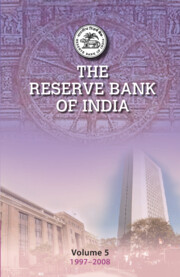Book contents
- Frontmatter
- Contents
- Tables
- Boxes
- Foreword
- Preface
- Acknowledgements
- List of Abbreviations
- 1 Introduction: Managing Liberalisation
- 2 The Macroeconomic Context
- 3 Monetary Management
- 4 Foreign Exchange Market and Management of the Capital Account
- 5 Foreign Exchange Reserves Management
- 6 Financial Markets
- 7 Public Debt Management
- 8 The Payment and Settlement Systems
- 9 Currency Management
- 10 Regulation of the Financial System – Part I: Commercial Banks
- 10 Regulation of the Financial System Part II: Other Financial Institutions
- 11 Supervision of the Financial System
- 12 Rural Credit
- 13 Financial Inclusion
- 14 Communication Policy
- 15 Organisational Change
- Appendices
- Photographs
- Select Bibliography
- Index
3 - Monetary Management
Published online by Cambridge University Press: 10 January 2023
- Frontmatter
- Contents
- Tables
- Boxes
- Foreword
- Preface
- Acknowledgements
- List of Abbreviations
- 1 Introduction: Managing Liberalisation
- 2 The Macroeconomic Context
- 3 Monetary Management
- 4 Foreign Exchange Market and Management of the Capital Account
- 5 Foreign Exchange Reserves Management
- 6 Financial Markets
- 7 Public Debt Management
- 8 The Payment and Settlement Systems
- 9 Currency Management
- 10 Regulation of the Financial System – Part I: Commercial Banks
- 10 Regulation of the Financial System Part II: Other Financial Institutions
- 11 Supervision of the Financial System
- 12 Rural Credit
- 13 Financial Inclusion
- 14 Communication Policy
- 15 Organisational Change
- Appendices
- Photographs
- Select Bibliography
- Index
Summary
Introduction
The conduct of monetary policy underwent significant changes during the years 1997–98 to 2007–08. Changes occurred in objectives, instruments, monitoring of economic indicators and the process of policymaking, including legal procedures. The present chapter will describe these changes. The rest of the chapter is divided into seven sections. Six of these deal with, in that order, the shift from monetary targeting to multiple indicators approach to monetary management, the liquidity adjustment facility (LAF), the Market Stabilisation Scheme (MSS), implications of the new regime for the Bank Rate, pricing of bank credit, and changes in process and legal procedures.
A brief account of the main areas of change may be useful, to begin with, to set the stage for a more detailed narrative the rest of the chapter will present.
An Overview
Objectives of Monetary Policy
Monetary policy traditionally served two objectives: keeping inflation under control and ensuring adequate flow of credit to the economy. During the reference period, these two remained the main aims. The relative emphasis, as usual, could shift from one to the other, depending on market conditions. From the late 1990s, a third objective was added. The change came mainly in response to developments in the external sector. This was to achieve financial stability by maintaining orderly conditions in financial markets (money, government securities and foreign exchange markets) and sustaining the health of the banking system in the face of increasing exposure to foreign currency inflows and external shocks.
Instruments
The instruments of monetary management changed during the reference period. Until 1997, regulation of bank credit via direct and indirect means, mainly interest rate regulation, was the most important instrument. Monetary management was earlier carried out through open market operations (OMOs) in the form of outright purchase or sale of government securities, regulation of the reserve ratio (or cash reserve ratio, CRR) and the statutory liquidity ratio (SLR), or mandatory holding of government securities by banks. The CRR was the major instrument for absorbing liquidity in the period before India’s economic liberalisation began and was usually set at a relatively high level. In addition, various refinance facilities helped the Reserve Bank ration out liquidity among banks for short periods.
- Type
- Chapter
- Information
- The Reserve Bank of IndiaVolume 5, 1997–2008, pp. 44 - 93Publisher: Cambridge University PressPrint publication year: 2023



